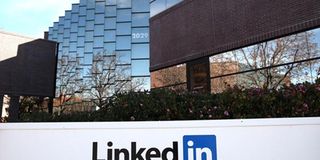How you can get yourself noticed — digitally

The front of the LinkedIn headquarters in Mountain View, California on February 11, 2011. PHOTO | JUSTIN SULLIVAN | FILE
What you need to know:
- Job search: Networking is key in looking for a job; the secret lies in how you market yourself.
- Unless you complete all sections of the profile, you will miss out on opportunities.
With colleges and universities being opened in every corner of the country, thousands of students are graduating every year and start job hunting. The market is not keeping pace at creating enough jobs for these graduates and those who want to change jobs.
Recruiters on the other hand are looking for ways to cut the clutter and identify the best the market has without sifting through tonnes of CVs, some of which don’t match the skills.
Many are turning to online tools to help identify candidates that fit their human resource needs.
If you are looking for a job therefore, you should cross the online path of a recruiter and be noticed. LinkedIn is one of the best online platforms for you and your professional friends and recruiters regularly come scouring for the best fit for their jobs.
The problem is that these people won’t find you if all you do is create an account, fill in some of your details and then sit back and wait for the emails to come in.
Unless you complete all sections of the profile, you will miss out on opportunities. Create a strong introduction, put as many keywords as you can into the specialties, list and write about every job you have held, and include all schools you attended, as well as any professional associations you belong to.
One way recruiters search for qualified talent on LinkedIn is by typing in keywords that are common in the skill sets they’re looking for.
PROFILE PICTURE
You therefore need to include the same keywords and phrases they’re searching for that describes your competencies.
Take a look at job descriptions placed by advertisers and pull out common buzz words that describe your capabilities. Then, use them to create or update your LinkedIn profile.
The advantage of using good keywords is that they will be indexed by Google and increase your visibility. This gives your profile tons of potential and opportunity to be viewed by the right people.
Make sure you have an appropriate picture on your profile. Chances are very high that if your profile does not have an image, it will get passed by. In many cases, we people see the picture first and then read the profile. Don’t we all do that?
An easy solution is to have a simple headshot, but that is boring these days. Be creative and really stand out.
Have a profile pic that paints a picture of what you do. If you’re a computer tech, take a pic of yourself surrounded by machines to repair.
If you’re a health worker, chef, teacher; get a pic of yourself in your working gear and possibly at work.
REGULAR UPDATES
Don’t be passive on LinkedIn. Keep in front of recruiters by posting relevant information, such as industry events, news and interesting articles.
Recruiters in your network will see your regular status updates and this will help them remember you as opportunities emerge. If you participate regularly, you’ll become a familiar name and boost your chances of being considered for a position.
Encourage your friends to recommend you. At the bottom of a LinkedIn profile, there is usually a place for that. Recommendations are a great way to get noticed.
Reach out to current and past colleagues and solicit a recommendation. One of the best ways to receive one is to send one to them yourself on their profile. They will likely reciprocate.
Bottom line is, you have to step out of the crowd and showcase your expertise. LinkedIn strategy has worked for me over and over again – and my profile still needs some more work. It has worked for some of my friends. It can work for you too. It’s free.
Make yourself seen by those who matter in your industry.
Sam Wambugu is a monitoring and evaluation specialist; [email protected]





